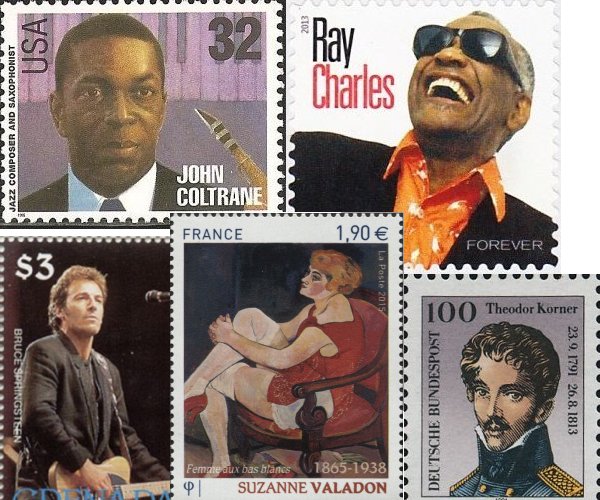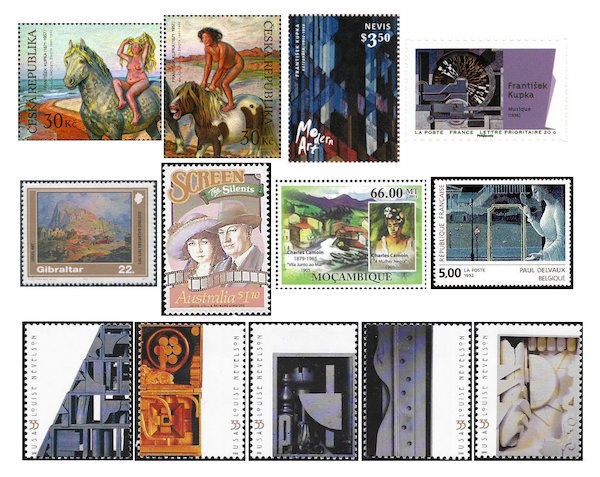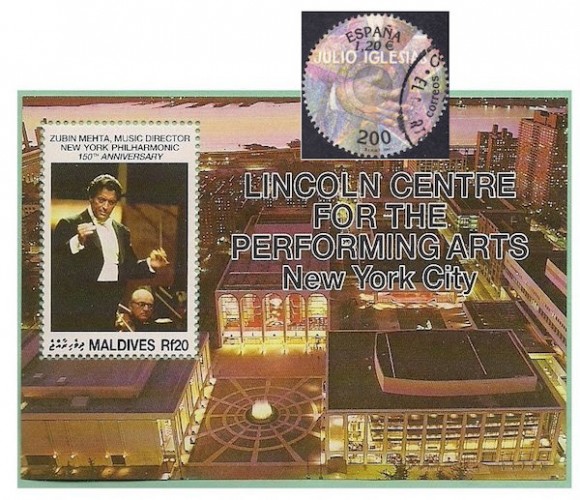The Arts on Stamps of the World — September 23
An Arts Fuse regular feature: the arts on stamps of the world.

By Doug Briscoe
Our three top subjects today are all among the greatest figures in American music. Given their fame and the length of today’s list of other artists (sixteen of them!), I’ll skimp on the biographical details for John Coltrane (September 23, 1926 – July 17, 1967), Ray Charles (September 23, 1930 – June 10, 2004), and Bruce Springsteen (born September 23, 1949).
Now step into the Wayback Machine, Sherman, as we turn to more historical, if less familiar, figures from the arts.
And indeed we go way, way back for the Icelandic historian and poet Snorri Sturluson, born in 1179, who died on this date in 1241. His election to the Icelandic parliament, the Althing, was due entirely to his renown as a poet. We leave aside the politically significant aspects of Snorri’s life to concentrate on his accomplishments in literature. His works include the Prose Edda (which may be merely a compilation of pre-existing material) and the Heimskringla, a history, partly legendary, of the Norwegian kings. He may also have been the author of Egil’s Saga. The stamps are from both Iceland and Norway, all for Snorri’s death septicentennial in 1941 except for the one from 1979 showing a page from Olaf’s Saga (c1225), another of Snorri’s works. The Norwegian set, besides offering a portrait of the poet, illustrates scenes from the sagas.
Now let’s stay in the frozen north but come forward in time about 450 years to the Hamburg-born Swedish portrait painter David Klöcker Ehrenstrahl (or Ehrenstråhle, 23 September 1628 – 23 October 1698). We have a lot of painters today—if you regard eight as a lot—and Ehrenstrahl is chronologically our first. His studies took him to the Netherlands and Italy, and he also visited the courts of France and England before returning to Sweden to be named court painter in 1661. His magnum opus is the ceiling fresco in the great hall of the Swedish House of Knights. This allegorical work, The Great Deeds of The Swedish Kings, was painted between 1670 and 1675. (He created a duplicate version for the Drottningholm Palace in 1695.) The large stamp (which happens to be the 1000th design by the great Polish stamp engraver Czesław Słania, whose birthday is next month) shows a piece of the 1695 version. One portion of the original fresco, The Crown of Immortality, can be seen here. The other stamp offers Ehrenstrahl’s portrait of the linguist and poet Georg Stiernhelm.

September 23 is also the birthday of Theodor Körner (1791 – 26 August 1813), poet, playwright, and soldier who was killed aged 21 while fighting against Napoleon’s forces. He and Schubert met in Vienna, and the composer subsequently set fourteen of Körner’s lyrics as well as writing a singspiel on the author’s play Der vierjährige Posten. Carl Maria von Weber also set much of Körner’s work in songs and choruses. In their younger days, both Hugo Wolf (“Ständchen“, 1877) and Richard Strauss (“Spielmann und Zither“, 1878) turned to Körner as well.
Our second painter today is Pekka Halonen (23 September 1865 – 1 December 1933) of Finland, who learned some of his craft from his father, an amateur decorative artist. After studies in Helsinki and Paris, where one of his teachers was Paul Gauguin, Halonen returned to Finland, married, and settled down to a life of painting his favored subjects of the Finnish landscape and people, as in The Mowers (1891), Maidens on the Headlands (1895), and Winter Day, the latter seen on the Halonen centennial stamp of 1965. The more recent stamp is one of a pair showing details of a double portrait of the artist and his wife, also from 1895. Since she was herself a translator, we’ll show her stamp on her birthday, November 30th.
A fascinating personage indeed is the French painter and artists’ model Suzanne Valadon (23 September 1865 – 7 April 1938), who happens also to have been the mother of Maurice Utrillo. She is no doubt most familiar as one of the subjects in Renoir’s famous painting Dance at Bougival (1883), which we can see on stamps from Sierra Leone and the Qu’aiti State of South Arabia. (Renoir painted her again as Girl Braiding Her Hair and Suzanne Valadon, both from 1885.) Born Marie-Clémentine Valadon, she never knew her father, and the father of Utrillo remains uncertain. She worked in the circus before beginning to pose at 15 for artists in Montmartre. Becoming interested in art, she taught herself by observing the painters and by reading. She had no formal education in art and never really could be confined to a particular tradition. Yet by 1894, Valadon was the first woman to be admitted to the Société Nationale des Beaux-Arts. In the preceding year she had had a brief affair with composer Erik Satie (whom she painted), but broke it off, which was devastating for him. At around this time she also got to know Edgar Degas, who bought her drawings and gave her further encouragement, remaining her friend until his death. One of the more interesting aspects of her output is that she was virtually alone among women artists of her day in painting the female nude, imbuing her pictures with a feminine perspective absent from most of the work of her male counterparts. Here is Joy of Life (1911) as an example. She left about 300 drawings and 450 oils. The Bulgarian stamp of 1990 shows a still life, and the new French stamp of 2015 her Femme aux bas blanc.

Another painter of the same generation was František Kupka (September 23, 1871 – June 24, 1957). An art student at Prague, where he painted historical and patriotic subjects, and Vienna, where he turned to allegorical topics, Kupka settled in Paris. He illustrated books and posters and contributed satirical drawings to periodicals. He had his first showing in 1906, suddenly turning to more abstract canvases in 1909. When World War I broke out, he signed up with the French Army despite his age of nearly 43. He was discharged after suffering frostbite. Much later he was a co-founder of Abstraction-Création, a group set up in opposition to the Surrealists. The pair of Czech stamps of 2012 shows a stylized reproduction of a single painting, Ballad of Epona from 1900. The one from Nevis gives us The Cathedral (1912-13), one of Kupka’s most celebrated canvases—Wikipedia devotes a whole page to it. Finally, the French issue depicts Musique (1936). To explore further, here is a link to some more of his paintings and illustrations.
Our fifth (and fourth consecutive) painter is Gustavo Bacarisas (23 September 1873 – 7 January 1971) of Gibraltar. Just like everybody else, Bacarisas studied in Paris, but he broke away from the pack by making Buenos Aires his home until 1916, later taking up residence in Seville. Bacarisas created the sets and costumes for the premiere of Manuel de Falla’s ballet El amor brujo in Madrid. He fled the country for the island of Madeira and his native Gibraltar during the Spanish Civil War, settling again in Seville after World War II. The stamp from 1991 shows his Northern View of Gibraltar.

Raymond Longford (23 September 1878 – 2 April 1959) was an important figure in early Australian film, working as director, writer, producer, and actor. As a younger man he had been a sailor before taking up stage acting in India! During this time he met Lottie Lyell, who would become his creative and romantic partner and is pictured with him on the stamp. He directed his first picture, The Fatal Wedding, in 1911; it was such a success that it financed his next few films and committed him to a career in the industry. His most popular film was The Sentimental Bloke (1919), held to be one of the finest Australian productions. After Lyell’s death from tuberculosis in 1925, Longford’s career never again reached the heights it had achieved during the silent era.
Back to painting again for our next two birthday boys. French artist Charles Camoin (23 September 1879 – 20 May 1965) was one of the initial members of the group labeled the Fauves. Camoin was born in Marseille and was a classmate of Matisse under Gustave Moreau at the Ecole des Beaux Arts in Paris. The only Camoin stamp I could find was one from Mozambique combining two paintings from the year 1905: Village By the Sea and Black Woman.
Belgian Surrealist Paul Delvaux (23 September 1897 – 20 July 1994) had an intellectually rich childhood of music lessons, Greek and Latin, and Jules Verne. His fondness for Homer found expression in his many early mythological drawings. His parents insisted he learn architecture but Delvaux was devoted to painting and had his first solo exhibition in 1925. One of his strongest influences up to this time was the work of Constant Permeke, but within a few years he was turning more in the direction of the style of Giorgio de Chirico. Delvaux’s favorite subjects were female nudes and…trains. The stamp gives us an example of both, but actually shows neither: we get a detail from A Visit to Ephesus (Le rendezvous d’Éphèse, 1973) that omits the nudes and the train (OK, it’s a streetcar). If you desire to see them, follow the link.

The American sculptor Louise Nevelson (September 23, 1899 – April 17, 1988) was honored with a full set of five stamps in the year 2000, just a tad late for her centenary. She was born Leah Berliawsky in the Poltava Governorate (now Ukraine) and came to the United States with her mother and siblings to join her father in Rockland, Maine. Leah spoke Yiddish at home and learned English at school, later taking as job as a stenographer in a law office. She married a client’s brother, Charles Nevelson, at a ceremony at Boston’s Copley Plaza Hotel. Nevelson worked a bit with painting and printing before turning decisively to sculpture. She often used found objects, preferably wood, in her massive pieces, with a Pre-Colombian influence making itself felt after a visit to Central America. In 1958 she appeared on the cover of Life magazine. The five pieces chosen for the stamps are representative of her bold, monochromatic style: Silent Music I, Royal Tide I, Black Chord, Nightsphere-Light, and Dawn’s Wedding Chapel I.
Czech writer Jaroslav Seifert (23 September 1901 – 10 January 1986) was awarded the Nobel Prize in 1984. In his earlier days he edited Communist periodicals in Prague but left the party over ideological differences. After 1949 he no longer worked in journalism. He had been recognized pretty much throughout his career as a significant voice in Czech poetry. A Jaroslav Seifert Prize, designed initially for Czech authors in exile during the Soviet period, was inaugurated in 1986.
Hindi poet Ramdhari Singh “Dinkar” (23 September 1908 – 24 April 1974) is regarded as one of the foremost modern poets in the language. Born in Bihar, he studied Hindi, Sanskrit, Bengali, Urdu, and English literature and found his infleunces in Tagore, Keats, and Milton. (He translated Tagore from Bengali to Hindi.) His own original poetry first appeared in print in 1924. As his work was nationalist and anti-British, he wrote under a pseudonym, “Amitabh”. His first collection in book form, Renuka, came out in 1935.
Oh, if only we had another painter to enjoy today! Wait a minute, there’s Carl-Henning Pedersen (23 September 1913 – 20 February 2007), called by some the “Scandinavian Chagall”. Born in poverty in Copenhagen, he was encouraged to take up painting by his wife, Else Alfelt, who was self-taught. He walked to Paris in 1939 and visited a “degenerate art” exhibit in Frankfurt on the way home. Of course, at variance with the point of the exhibit, he liked what he saw, especially the work of Chagall, and he persisted in producing abstract work even during the German occupation. After the war he and his wife were founding members of the COBRA movement. One of his late efforts was the redecoration of the Gothic cathedral in Ribe, Denmark, for which he created murals, glass, and mosaics. The stamp set from 1987 shows one example of each.
Viennese-born actress Romy Schneider (23 September 1938 – 29 May 1982) grew up as Rosemarie Magdalena Albach in a family of actors. Her first film appearance, at the age of 15, was followed two years later by a breakthrough in the historical drama Sissi (1955) and its two sequels, in which she played Empress Elisabeth of Austria. In 1972 she would reprise the role one last time for Visconti’s Ludwig (see the label attached to the Gilbraltar stamp). She fell in love with Alain Delon while they were filming Christine (1958), and was involved with him until 1963. Schneider chose to live mostly in France and held German and French citizenship. She has been honored on three stamps of two nations and one territory, Germany, Austria, and Gibraltar. (What, no French stamp?)

Spanish singing star Julio Iglesias (born 23 September 1943) turns 74 today. I gather from Wikipedia that he is a) “the most commercially successful European singer in the world,” b) “one of the top ten record sellers in music history” (350 million records), c) the most popular international artist in China, and d) the biggest selling Spanish recording artist in history (23 million records). He has sung in 14 languages in 5000 concerts before 60 million people on five continents. Well, OK, then.
Also on this day in 1962, the Lincoln Center for the Performing Arts, specifically Philharmonic Hall (now David Geffen Hall), opened in New York City. The souvenir sheet was issued by the Maldive Islands for the thirtieth anniversary in 1992, as well as for the 150th anniversary of the NY Phil.
And we give mention to the author of The Scarlet Pimpernel (play, 1903; novel, 1905), the Baroness Orczy (ORT-see; 23 September 1865 – 12 November 1947). I’ve never read it. Should I?
A graduate of the University of Massachusetts with a B.A. in English, Doug Briscoe worked in Boston classical music radio, at WCRB, WGBH, and WBUR, for about 25 years, beginning in 1977. He has the curious distinction of having succeeded Robert J. Lurtsema twice, first as host of WGBH’s weekday morning classical music program in 1993, then as host of the weekend program when Robert J.’s health failed in 2000. Doug also wrote liner notes for several of the late Gunther Schuller’s GM Recordings releases as well as program notes for the Boston Classical Orchestra. For the past few years he’s been posting a Facebook “blog” of classical music on stamps of the world, which has now been expanded to encompass all the arts for The Arts Fuse.
